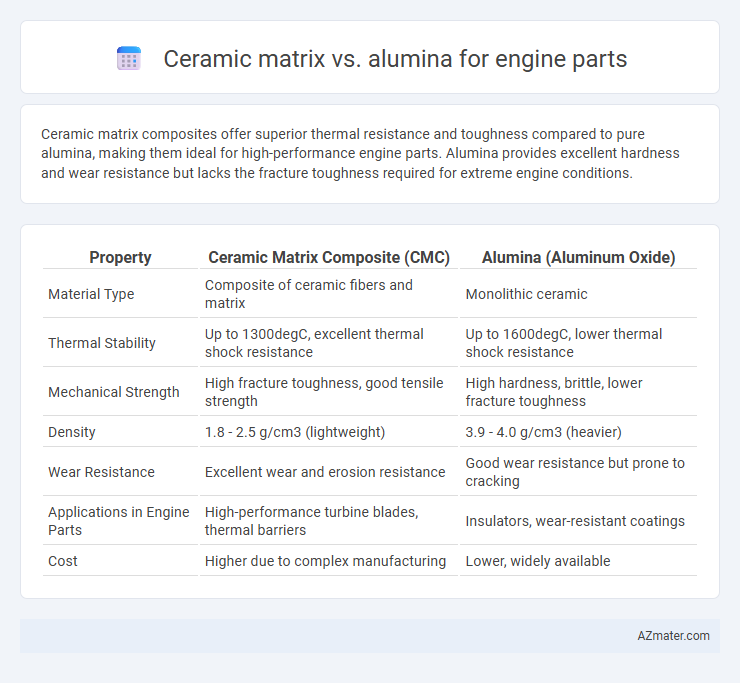Ceramic matrix composites offer superior thermal resistance and toughness compared to pure alumina, making them ideal for high-performance engine parts. Alumina provides excellent hardness and wear resistance but lacks the fracture toughness required for extreme engine conditions.
Table of Comparison
| Property | Ceramic Matrix Composite (CMC) | Alumina (Aluminum Oxide) |
|---|---|---|
| Material Type | Composite of ceramic fibers and matrix | Monolithic ceramic |
| Thermal Stability | Up to 1300degC, excellent thermal shock resistance | Up to 1600degC, lower thermal shock resistance |
| Mechanical Strength | High fracture toughness, good tensile strength | High hardness, brittle, lower fracture toughness |
| Density | 1.8 - 2.5 g/cm3 (lightweight) | 3.9 - 4.0 g/cm3 (heavier) |
| Wear Resistance | Excellent wear and erosion resistance | Good wear resistance but prone to cracking |
| Applications in Engine Parts | High-performance turbine blades, thermal barriers | Insulators, wear-resistant coatings |
| Cost | Higher due to complex manufacturing | Lower, widely available |
Introduction to Advanced Engine Materials
Ceramic matrix composites (CMCs) and alumina are advanced materials increasingly utilized in engine components for their high-temperature stability and wear resistance. CMCs offer superior toughness and thermal shock resistance compared to monolithic alumina, enabling improved fuel efficiency and durability under extreme engine conditions. Engine manufacturers prioritize CMCs when optimizing performance parameters like weight reduction and heat tolerance while alumina remains a cost-effective option for components requiring high hardness and electrical insulation.
Overview of Ceramic Matrix Composites
Ceramic matrix composites (CMCs) offer enhanced toughness and thermal resistance compared to traditional alumina ceramics, making them suitable for high-performance engine parts exposed to extreme temperatures and mechanical stress. CMCs combine ceramic fibers with a ceramic matrix to improve fracture toughness and reduce brittleness, providing superior durability and weight savings over monolithic alumina components. These properties enable engine manufacturers to achieve higher efficiency and longer service life in demanding environments such as turbine blades and exhaust systems.
Understanding Alumina: Properties and Applications
Alumina, or aluminum oxide, exhibits exceptional hardness, high thermal stability, and excellent wear resistance, making it a preferred ceramic matrix for engine parts requiring durability under extreme conditions. Its high melting point (over 2,000degC) and superior corrosion resistance ensure reliable performance in high-temperature, high-stress environments such as combustion chambers and turbocharger components. These properties enable alumina-based components to enhance engine efficiency and longevity compared to traditional metal parts.
Mechanical Strength: Ceramic Matrix vs Alumina
Ceramic matrix composites (CMCs) exhibit superior mechanical strength compared to alumina due to their enhanced fracture toughness and resistance to crack propagation, making them ideal for high-stress engine parts. Alumina, while possessing high hardness and wear resistance, tends to be more brittle and prone to catastrophic failure under mechanical load. The combination of ceramic fibers and matrix materials in CMCs significantly improves impact resistance and durability in demanding engine environments.
Thermal Resistance Comparison
Ceramic matrix composites exhibit superior thermal resistance compared to alumina, maintaining structural integrity at temperatures exceeding 1000degC, while alumina typically withstands up to approximately 1700degC but is more brittle under thermal stress. Engine parts made from ceramic matrix materials benefit from enhanced thermal shock resistance and lower thermal expansion, reducing the risk of cracking during rapid temperature fluctuations. Alumina's high thermal conductivity aids in heat dissipation but its lower fracture toughness limits its effectiveness in high-stress engine environments.
Weight and Density Analysis
Ceramic matrix composites (CMCs) typically exhibit lower density values, around 2.5-3.0 g/cm3, compared to alumina ceramics, which have densities near 3.9-4.1 g/cm3, making CMCs significantly lighter for engine part applications. The reduced weight of CMCs contributes to improved engine efficiency and performance by lowering overall mass while maintaining high-temperature resistance and mechanical strength. Density optimization between ceramic matrix and alumina materials directly impacts thermal management and fuel efficiency in advanced engine designs.
Wear and Corrosion Performance
Ceramic matrix composites (CMCs) exhibit superior wear resistance compared to alumina due to their enhanced toughness and crack tolerance, making them ideal for high-stress engine parts. Alumina offers excellent corrosion resistance in acidic and oxidative environments, but its brittleness limits long-term durability under cyclic loads. CMCs provide a balanced performance by combining the corrosion resistance of ceramics with improved mechanical strength, resulting in extended service life for engine components exposed to harsh operational conditions.
Manufacturing and Cost Considerations
Ceramic matrix composites offer superior thermal resistance and strength for engine parts but involve complex manufacturing processes such as hot pressing or chemical vapor infiltration, increasing production time and costs. Alumina, while less thermally resilient, benefits from established manufacturing methods like sintering and is generally more cost-effective for high-volume engine component production. Cost considerations often favor alumina for standard applications, whereas ceramic matrix composites are preferred in high-performance engines despite their higher manufacturing expenses.
Real-World Engine Applications
Ceramic matrix composites (CMCs) offer superior thermal resistance and toughness compared to alumina ceramics, making them ideal for high-performance engine components such as turbine blades and exhaust valves in aerospace and automotive sectors. Alumina provides excellent hardness and wear resistance but lacks the fracture toughness required for critical engine parts exposed to extreme mechanical stress. Real-world applications favor CMCs for their lightweight properties and ability to withstand temperatures exceeding 1,200degC, enhancing engine efficiency and durability under harsh operating conditions.
Future Trends in Engine Material Selection
Future trends in engine material selection emphasize the integration of ceramic matrix composites (CMCs) due to their superior high-temperature resistance, lightweight properties, and enhanced mechanical strength compared to traditional alumina ceramics. Advances in ceramic matrix technology enable improved thermal stability and oxidation resistance, crucial for next-generation high-performance engines aiming for increased fuel efficiency and reduced emissions. Industry research increasingly focuses on tailoring CMC microstructures to outperform alumina in wear resistance and durability under extreme operating conditions.

Infographic: Ceramic matrix vs Alumina for Engine part
 azmater.com
azmater.com